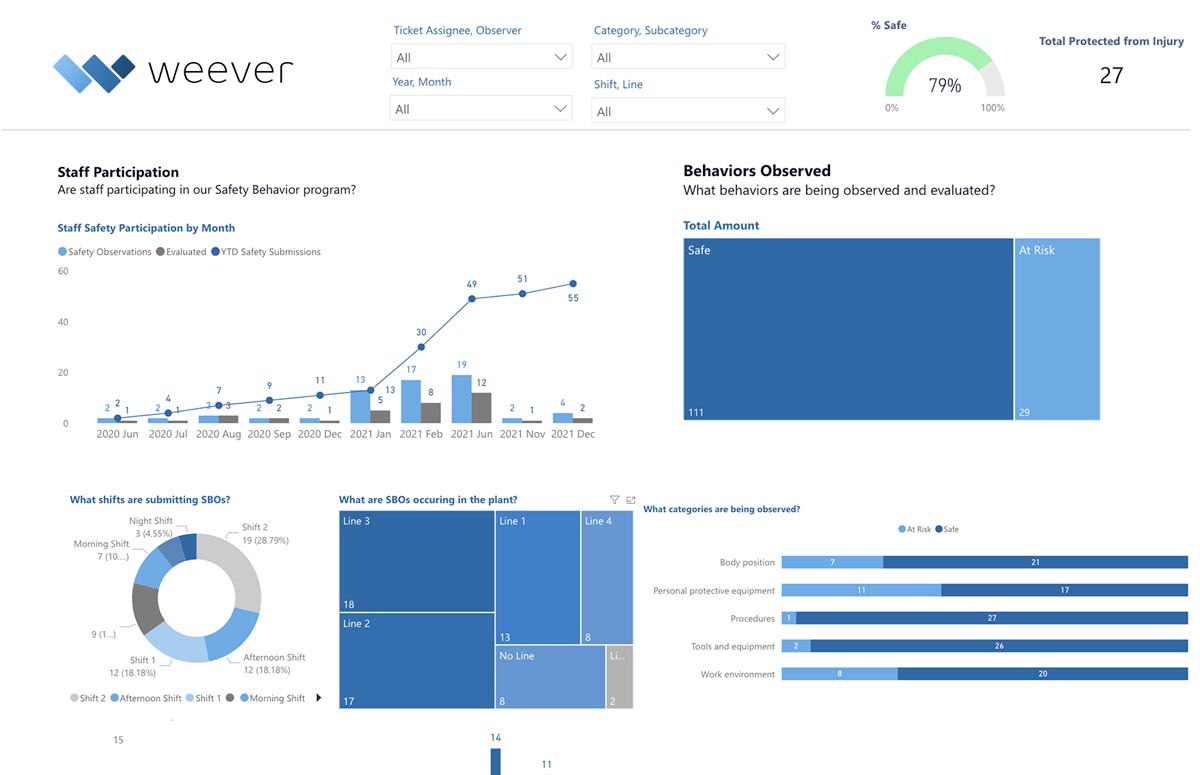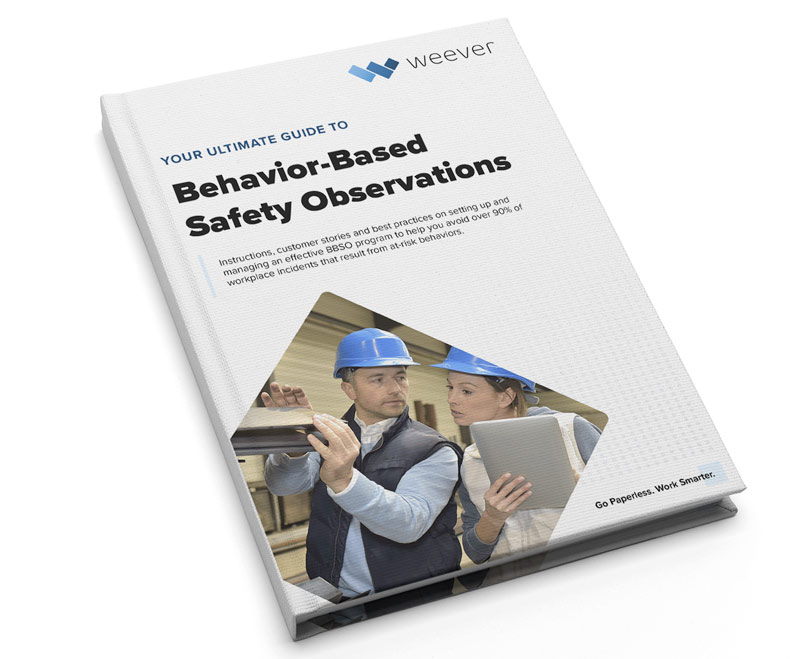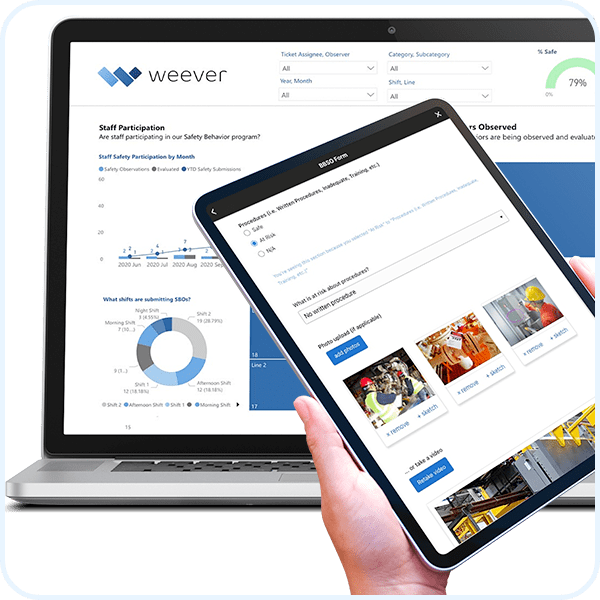How to build and manage a successful BBSO Program
Simple 5 Step Guide to ensuring your BBSO program drives tangible safety results.

If you're a safety or operations manager in a manufacturing company, you know that a strong safety culture is the foundation of success. One of the most effective tools at your disposal is Behavior-Based Safety (BBS) observations.
If you’re interested in learning how BBSO programs work, you’ve come to the right place. In this practical guide, we're going to break down the process, ensuring that you become a BBS expert and lead your team towards a safer, happier workplace.
Successful BBSO strategies will change from company to company - so start slow, work out the kinks, and be ready for some trial and error before rolling out fully. That being said, all BBSO programs include a method to capture observations, a process to evaluate and action plan, and a means to review program results and KPIs.
Implementing a Behavior-Based Safety Observation (BBSO) program is essential for fostering a proactive safety culture within organizations. The following steps outline a structured approach to establishing an effective BBSO program.
1. Define Clear Objectives
Before launching your program you need to consider the overall objectives of your program, the format of your observation form, who will be observing employees and capturing data, BBSO training and setting a schedule to ensure compliance.
Establishing specific, measurable goals is the foundation of a successful BBSO program. These objectives should align with the organization’s overall safety strategy and address identified risks. For instance, aiming to reduce near-miss incidents related to personal protective equipment (PPE) non-compliance by 20% within six months provides a clear target for the program.
- To establish effective BBSO program objectives, start by identifying the specific safety behaviors or practices you want to target, such as the proper use of personal protective equipment (PPE) or adherence to lockout/tagout procedures.
- Determine the desired outcomes, which could include reducing the number of safety incidents, lowering injury rates, or enhancing overall safety culture.
Ensure that your objectives are SMART: Specific, Measurable, Achievable, Relevant, and Time-bound. For instance, an objective could be to "reduce the number of near-miss incidents related to PPE non-compliance by 20% within six months." These well-defined objectives provide a clear roadmap for the BBSO program, aligning efforts with tangible safety improvements.
Select Observer Methodology
You can either select and train specific staff members (such as members of the safety committee) to be observers or provide all staff with the ability to submit safety observations (Peer-to-Peer).
- Limiting observers makes the program a bit easier to manage but it does reduce the amount of teachable moments that can arise from safety observations.
- Peer-to-peer behavior-based safety observation programs create a collaborative, engaging, and proactive approach to safety that can significantly enhance the overall safety culture within an organization. Learn more about how one of our customers transformed their safety culture with peer-to-peer observations.
By leveraging the power of employees to monitor, provide feedback, and support each other in safe behaviors, companies can reduce incidents, improve safety performance, and create a workplace where safety is everyone's responsibility.
Learn more the benefits of the Peer-to-Peer observation approach here: https://weeverapps.com/behavior-based-safety/peer-to-peer/
2. Develop User-Friendly Observation Forms
Creating standardized and straightforward observation forms ensures consistency and ease of use.
When creating a Behavior-Based Safety Observation (BBSO) form, it's essential to focus on capturing relevant and actionable data that contributes to improved safety practices.
- Start by identifying the critical safety behaviors specific to your workplace. These are the behaviors that, if followed or corrected, have the most significant impact on safety.
- Ensure the BBSO form is user-friendly, with clear instructions and checkboxes or fields for observations, including antecedents (what led to the behavior), the behavior itself, and consequences (results of the behavior).
- Make it practical and concise to encourage regular use by observers.
- Consider including space for positive reinforcement and corrective actions to promote a collaborative approach to safety improvement.
- Regularly review and update the form to reflect changing safety priorities and maintain its relevance in driving a safer work environment.
At Weever, we have a few BBSO templates for you to customize to your unique requirements. Our templates focus on capturing data in the following categories:
- Body Position - Are the employees pivoting or twisting? Is there a risk of falling? How is their posture?
- PPE - Are they wearing the appropriate protective equipment for the job?
- Tools & Equipment - Were the tools appropriate for the job? Are they in good condition and used appropriately?
- Work Environment - Was the area clear of hazards or unorganized? Are there any sanitation or housekeeping issues?
- Procedures - Were required procedures followed as outlined by your documentation?
Looking for a Scorecard Template (.docx) to get you started: https://weeverapps.com/bbso-doc
3. Conduct Comprehensive Training
Proper training equips observers with the skills necessary to identify and document both safe and at-risk behaviors.
Safety managers should provide training around what to observe, when, and how often. Usually BBSO training is mandatory on-boarding for new hires. BBSO training is crucial to instill a strong safety culture from the very beginning. Training should consist of:
- Introduction to Safety Culture - Emphasize the organization's commitment to safety
- Basic Safety Principles - Provide an overview of basic safety principles
- Explanation of BBS - Define what Behavior-Based Safety is and why it's essential.
- Critical Behaviors Identification - Identify and explain the critical safety behaviors relevant to the specific job roles within your organization.
- Reporting Procedures - Describe the process for reporting safety concerns, near misses, and incidents.
- Positive Reinforcement - Highlight the importance of positive reinforcement in BBS.
- Feedback and Communication Skills - Provide training on effective communication skills for giving feedback. Emphasize the need to be respectful, non-judgmental, and solution-oriented when addressing safety concerns with colleagues.
- Safety Resources: Familiarize new employees with safety resources within the organization, including safety committees, safety officers, and any safety training materials or online platforms.
Consider scheduling follow-up training sessions or refreshers to reinforce BBS principles and address any questions or concerns that may arise after the initial onboarding. By incorporating these elements into the onboarding process, you can ensure that new employees are well-equipped to embrace the organization's safety culture and actively contribute to a safer workplace through Behavior-Based Safety practices.
This training ensures that observers can effectively contribute to the program’s success.
4. Schedule Regular Observations
Implementing a consistent observation schedule is crucial for maintaining momentum and focus on safety. Regular observations allow for the timely identification of unsafe behaviors and reinforcement of safe practices. This consistency helps in building a culture where safety is continuously monitored and improved.
Creating a Behavior-Based Safety Observation (BBSO) schedule is crucial to ensure consistent and effective safety monitoring.
- Start by identifying the frequency and scope of observations needed for your organization's safety goals.
- Consider factors like the size of your workforce, the complexity of your operations, and any specific safety concerns.
- Divide your employees into observation pairs or groups if needed.
- Establish a regular schedule, which may include daily, weekly, or monthly observation slots, depending on your safety objectives and resources.
- Ensure that observation times are varied to capture different shifts and work conditions.
- Be flexible and allow for adjustments as needed to accommodate operational changes or evolving safety priorities.
- Communication and coordination among observers are key, so make sure the schedule is accessible and understood by all involved parties.
Finally, regularly review and update the schedule to align with changing safety needs and continuously improve your BBSO program.
How to properly conduct a Safety Observation
Conducting a behavior-based safety observation involves systematically observing and documenting workplace behaviors to identify potential safety hazards and promote safe practices.
- A BBSO consists of one or more persons completing a task, while at the same time one or more persons are observing that task with the explicit goal of identifying safe and at-risk practices.
- The observers then share those observations and offer suggestions on how to improve the at-risk work habits.
In this phase, employees and/or safety committee members are tasked with executing behavioral observations periodically on other staff and/or on-site contractors.
Observations include monitoring body position, PPE, tools & equipment, the general work environment and procedures.
This feedback should be conversational while encouraging discussion between the observer and observed employees.
In the end, safe and at-risk observations are reported and feedback is provided to the observed party.
When you're ready to begin the observation:
- Ask First: Remember to ask if it's okay to observe before beginning. It's all about growth, not getting people in trouble.
- Record Data: Use your observation form to document what you see. Be objective and specific in your notes. Include details about antecedents (what led to the behavior), the behavior itself, and any consequences (results of the behavior).
- Maintain Observer Neutrality: Avoid interfering with the observed employee's actions. Do not provide feedback or correction during the observation itself.
- Stay Non-Judgmental: Maintain a non-judgmental attitude and refrain from assigning blame. The goal is to gather data for improvement, not to criticize.
Providing Feedback
After the observation you should acknowledge safe behaviors. Start with positive feedback.
- Recognize and commend employees for safe behaviors you observed.
- This reinforces the importance of safe practices. Then you can address any unsafe behaviors you observed.
- Use constructive language and focus on the behavior, not the individual.
- Explain the potential consequences and emphasize the importance of safety.
Collaborate for Improvement
Encourage open communication. Ask them for their perspective on the observed behaviors and any barriers they face in performing safely.
- Collaborate with the employee to identify potential solutions to address safety issues.
- Discuss strategies to prevent unsafe behaviors and improve safety.
- By following these steps, you can conduct behavior-based safety observations effectively, promote a culture of safety, and contribute to a safer and healthier workplace for your team.
- Remember that the key to success is continuous improvement and a commitment to fostering safe behaviors.

5. Action Plan and Provide Constructive Feedback
When observations are submitted, supervisors and manager can review them and create action plans. While evaluation is usually focused mostly on at-risk behaviors, safe observation reports are still worth reviewing, especially if comments are provided.
With digitized solutions, photos and videos of safe behaviors can help by providing content for training purposes. All data, including safe reports, should be summarized to inform KPIs. Digital solutions, again, help with this because the reporting can be automated, which saves loads of time and ensures accuracy.
At risk behaviors can create a few different action plans:
1. One-on-One Follow Up
If you feel that the at-risk behavior could present a problem in the future, you can plan a quick follow-up with the observed parties to review appropriate safety SOP and best practices.
2. One Point Lessons & Training
If an at-risk situation continues to arise, managers can create a One Point Lesson or “Toolbox Talk” session where all staff will review the best practice.
- Video showing the safe behavior can be helpful. In some cases, simply asking area or shift supervisors to reiterate the importance of avoiding the at-risk behavior during a shift huddle is enough to make the
point clear. - For compliance purposes, it is best practice to get staff to sign a document that they received the training, which is much easier to manage using software.
3. Update Visual Controls
Add signs, indicators, and other visual cues to ensure commonly reported issues do not continue to occur.
For example, if there is a recurring issue with staff not using the appropriate hand protection in a certain area, hang a big sign that makes expectations clear.
Regularly review and analyze the collected data. Look for trends, patterns, and recurring safety issues. Use this analysis to drive continuous improvement initiatives.
____
Based on your analysis, implement corrective actions to address identified safety concerns. Monitor the effectiveness of these actions. Behavior-based safety observations should be an ongoing process. Regularly repeat observations to track progress and ensure that safety behaviors continue to improve.
By systematically implementing these steps, organizations can enhance their safety performance, reduce incidents, and cultivate a workplace where safety is a shared responsibility. This structured approach not only mitigates risks but also promotes a culture of continuous improvement and employee engagement.




